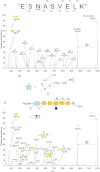Modification of the Campylobacter jejuni N-linked glycan by EptC protein-mediated addition of phosphoethanolamine
- PMID: 22761430
- PMCID: PMC3436159
- DOI: 10.1074/jbc.M112.380212
Modification of the Campylobacter jejuni N-linked glycan by EptC protein-mediated addition of phosphoethanolamine
Abstract
Campylobacter jejuni is the major worldwide cause of bacterial gastroenteritis. C. jejuni possesses an extensive repertoire of carbohydrate structures that decorate both protein and non-protein surface-exposed structures. An N-linked glycosylation system encoded by the pgl gene cluster mediates the synthesis of a rigidly conserved heptasaccharide that is attached to protein substrates or released as free oligosaccharide in the periplasm. Removal of N-glycosylation results in reduced virulence and impeded host cell attachment. Since the N-glycan is conserved, the N-glycosylation system is also an attractive option for glycoengineering recombinant vaccines in Escherichia coli. To determine whether non-canonical N-glycans are present in C. jejuni, we utilized high throughput glycoproteomics to characterize C. jejuni JHH1 and identified 93 glycosylation sites, including 34 not previously reported. Interrogation of these data allowed the identification of a phosphoethanolamine (pEtN)-modified variant of the N-glycan that was attached to multiple proteins. The pEtN moiety was attached to the terminal GalNAc of the canonical N-glycan. Deletion of the pEtN transferase eptC removed all evidence of the pEtN-glycan but did not globally influence protein reactivity to patient sera, whereas deletion of the pglB oligosaccharyltransferase significantly reduced reactivity. Transfer of eptC and the pgl gene cluster to E. coli confirmed the addition of the pEtN-glycan to a target C. jejuni protein. Significantly reduced, yet above background levels of pEtN-glycan were also observed in E. coli not expressing eptC, suggesting that endogenous E. coli pEtN transferases can mediate the addition of pEtN to N-glycans. The addition of pEtN must be considered in the context of glycoengineering and may alter C. jejuni glycan-mediated structure-function interactions.
Figures






Similar articles
-
EptC of Campylobacter jejuni mediates phenotypes involved in host interactions and virulence.Infect Immun. 2013 Feb;81(2):430-40. doi: 10.1128/IAI.01046-12. Epub 2012 Nov 26. Infect Immun. 2013. PMID: 23184526 Free PMC article.
-
Characterization of unique modification of flagellar rod protein FlgG by Campylobacter jejuni lipid A phosphoethanolamine transferase, linking bacterial locomotion and antimicrobial peptide resistance.J Biol Chem. 2012 Jan 27;287(5):3326-36. doi: 10.1074/jbc.M111.321737. Epub 2011 Dec 9. J Biol Chem. 2012. PMID: 22158617 Free PMC article.
-
Crystallographic study of the phosphoethanolamine transferase EptC required for polymyxin resistance and motility in Campylobacter jejuni.Acta Crystallogr D Biol Crystallogr. 2014 Oct;70(Pt 10):2730-9. doi: 10.1107/S1399004714017623. Epub 2014 Sep 27. Acta Crystallogr D Biol Crystallogr. 2014. PMID: 25286856 Free PMC article.
-
Identifying the targets and functions of N-linked protein glycosylation in Campylobacter jejuni.Mol Omics. 2020 Aug 10;16(4):287-304. doi: 10.1039/d0mo00032a. Mol Omics. 2020. PMID: 32347268 Review.
-
The Campylobacter jejuni glycome.FEMS Microbiol Rev. 2005 Apr;29(2):377-90. doi: 10.1016/j.femsre.2005.01.003. FEMS Microbiol Rev. 2005. PMID: 15808749 Review.
Cited by
-
Bacterial protein N-glycosylation: new perspectives and applications.J Biol Chem. 2013 Mar 8;288(10):6912-20. doi: 10.1074/jbc.R112.417857. Epub 2013 Jan 17. J Biol Chem. 2013. PMID: 23329827 Free PMC article. Review.
-
Selective biochemical labeling of Campylobacter jejuni cell-surface glycoconjugates.Glycobiology. 2015 Jul;25(7):756-66. doi: 10.1093/glycob/cwv016. Epub 2015 Mar 11. Glycobiology. 2015. PMID: 25761366 Free PMC article.
-
In vitro activity of Neisseria meningitidis PglL O-oligosaccharyltransferase with diverse synthetic lipid donors and a UDP-activated sugar.J Biol Chem. 2013 Apr 12;288(15):10578-87. doi: 10.1074/jbc.M112.432815. Epub 2013 Mar 4. J Biol Chem. 2013. PMID: 23460642 Free PMC article.
-
Analysis of zwitterionic and anionic N-linked glycans from invertebrates and protists by mass spectrometry.Glycoconj J. 2016 Jun;33(3):273-83. doi: 10.1007/s10719-016-9650-x. Epub 2016 Feb 22. Glycoconj J. 2016. PMID: 26899268 Free PMC article. Review.
-
Polymyxin: Alternative Mechanisms of Action and Resistance.Cold Spring Harb Perspect Med. 2016 Oct 3;6(10):a025288. doi: 10.1101/cshperspect.a025288. Cold Spring Harb Perspect Med. 2016. PMID: 27503996 Free PMC article. Review.
References
-
- Butzler J. P. (2004) Campylobacter, from obscurity to celebrity. Clin. Microbiol. Infect. 10, 868–876 - PubMed
-
- Snelling W. J., Matsuda M., Moore J. E., Dooley J. S. (2005) Campylobacter jejuni. Lett. Appl. Microbiol. 41, 297–302 - PubMed
-
- Hannu T., Kauppi M., Tuomala M., Laaksonen I., Klemets P., Kuusi M. (2004) Reactive arthritis following an outbreak of Campylobacter jejuni infection. J. Rheumatol. 31, 528–530 - PubMed
-
- Hughes R. A., Cornblath D. R. (2005) Guillain-Barré syndrome. Lancet 366, 1653–1666 - PubMed
-
- Lecuit M., Abachin E., Martin A., Poyart C., Pochart P., Suarez F., Bengoufa D., Feuillard J., Lavergne A., Gordon J. I., Berche P., Guillevin L., Lortholary O. (2004) Immunoproliferative small intestinal disease associated with Campylobacter jejuni. N. Engl. J. Med. 350, 239–248 - PubMed
Publication types
MeSH terms
Substances
LinkOut - more resources
Full Text Sources
Other Literature Sources
Molecular Biology Databases

